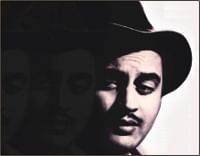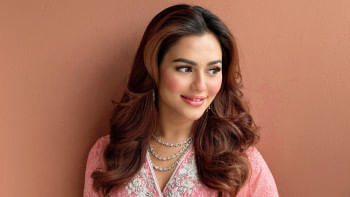Guru Dutt: Incorporating artistic sensibility in commercial films

July 9 marked legendary Indian filmmaker Guru Dutt's 83rd birthday. Dutt is often credited with ushering in the golden era of Indian cinema. He made the quintessential 1950-'60s classics such as Kaagaz Ke Phool, Pyaasa, Sahib Biwi Aur Ghulam and Chaudhvi Ka Chaand.
He is most famous for making brilliant lyrical and artistic films within the context of popular Indian cinema of the 1950s, and expanding its commercial conventions, starting with his 1957 masterpiece, Pyaasa. Several of his later works have a cult following. His movies go full house when re-released; especially in Germany, France and Japan. Today, no world cinema class is complete without inclusion of Guru Dutt. Pyaasa was rated as one of the best 100 films of all time by the Time Magazine.
Guru Dutt was born Vasanth Kumar Shivashankar Padukone in Bangalore to Shivashankar Rao Padukone and Vasanthi Padukone. His parents were Chitrapur Saraswats, originally settled at Panambur, a village in South Kanara district of Karnataka. His father was initially a headmaster, and then a bank employee. His mother Vasanthi, while initially a housewife, later taught in a school, gave private tuition and also wrote short stories and translated Bengali novels into Kannada.
Guru Dutt had a tough childhood with financial difficulties, and a strained relationship between his parents. As a child he had some bad experiences; the hostility from his maternal uncle's family, a frightening encounter with his insane maternal adopted uncle, and the death of his seven-month old brother.
After a childhood accident, he was renamed Guru Dutt, which was felt to be a more auspicious name.
Guru Dutt's father moved jobs to work as an administrative clerk at the Burmah Shell company and began living at Bhawanipore near Calcutta, where Guru Dutt finished his schooling. Hence, Guru Dutt spoke fluent Bengali, and carried a distinct stamp of Bengali culture in his work. Later, when he moved to Bombay in the 1940s, he dropped the Shivashankar Padukone part of his name, and was known simply as Guru Dutt. Because Dutt is a common Bengali last name, many people assumed that he was Bengali.
He was a good student, but never went to college, partly because of financial troubles at home. Instead, he joined the performing arts troupe of Uday Shankar.
The Uday Shankar India Culture Center at Almora taught dance, drama, and music. Guru Dutt joined the centre at age 16 in 1941 on a five-year scholarship of Rs. 75 annually, and studied at Almora until 1944, when the advancing World War II forced the closing of the centre.
Dutt joined his parents in Mumbai in 1944. Dutt's uncle found him a job under a three-year contract with the Prabhat Film Company in Pune the same year. It is here that Guru Dutt met two people who would remain his good friends -- actors Rehman and Dev Anand.
Guru Dutt acted in a small role as Sri Krishna in Chand in 1944. In 1945, he acted as well as assisted director Vishram Bedekar in Lakhrani, and in 1946 he worked as an assistant director and choreographed dances for P.L. Santoshi's film, Hum Ek Hain.
This contract ended in 1947, but his mother got him a job as a freelance assistant with Baburao Pai, the CEO of the Prabhat Film Company and Studio. Guru Dutt developed a flair for writing in English, and wrote short stories for The Illustrated Weekly of India, a local weekly English magazine.
It is during this time that he is supposed to have written the script for the almost autobiographical Pyaasa.
After Prabhat failed in 1947, Dutt moved to Bombay, where he worked with two leading directors of the time, with Amiya Chakravarty in Girl's School, and with Gyan Mukherjee in the Bombay Talkies film Sangram. Then, Dev Anand offered him a job as a director in his new company, Navketan, after the first movie had flopped.
Thus, Guru Dutt's first film, Navketan's Baazi, was released in 1951. It was a tribute to the 1940s' Film Noir Hollywood with the morally ambiguous hero, the transgressing siren, and shadow lighting.
There exists a very interesting anecdote behind this new job. Guru Dutt and Dev Anand used the services of the same laundry man when they were at Prabhat in Pune in 1945. One day Dev found that one of his shirts had been replaced with a different one. On arriving at work as the hero of Hum Ek Hain, he found the film's young choreographer (Guru Dutt) wearing his shirt. On being questioned, Guru Dutt admitted that it was not his shirt, but since he had no other, he was wearing the replacement. This developed into a great friendship, since they were of the same age. They promised each other that, if Guru Dutt were to turn filmmaker, he would hire Dev as his hero, and if Dev were to produce a film then he would use Guru Dutt as its director.
Dev Anand fulfilled his end of the bargain with Baazi, but still regrets that his friend Guru Dutt did not. Guru Dutt indirectly did fulfil his promise. His studio, Guru Dutt Films Pvt. Ltd, produced C.I.D. which starred Dev, but the film was directed by Raj Khosla (an assistant director to Guru Dutt).
Remembering his old friend Guru Dutt, Dev quotes, “He was a young man he should not have made depressing pictures…”
Baazi also highlights two early key technical developments in Indian movie-making that are attributed to Guru Dutt. The use of close-up shots with a 100 mm lens -- there are over 14 in the movie -- which became known in Indian movie-making as the "Guru Dutt shot", and the use of songs to further the narrative in the movie. Guru Dutt met his future wife, Geeta Ghosh Roy Chowdhury (later known as Geeta Dutt) during the making of the movie.
Baazi was an immediate success. Guru Dutt followed it with Jaal and Baaz. Neither film did well at the box office, but they bring together the Guru Dutt team that performed so brilliantly in subsequent films. He discovered, and mentored, Johnny Walker (comedian), V.K. Murthy (cinematography), and Abrar Alvi (writing and directing), among others. He is also credited for introducing Waheeda Rehman to the Hindi cinema. Baaz was notable in that Guru Dutt both directed and starred, not having found a suitable actor for the principal character.
Fortune smiled on Dutt's next film, Aar Paar (1954). This was followed by the 1955 hit, Mr. and Mrs. 55, then CID, Sailaab, and in 1957, Pyaasa -- the story of a poet, rejected by an uncaring world, who achieves success only after his apparent death. Guru Dutt played the lead role in three of these five films.
Dutt's Kaagaz Ke Phool (1959) was an intense disappointment. He had invested a great deal of love, money, and energy in this film, which was a self-absorbed tale of a famous director (played by Guru Dutt) who falls in love with an actress (played by Waheeda Rehman, Dutt's real-life love interest). Kaagaz Ke Phool failed at the box office and Dutt was devastated. All subsequent films from his studio were, thereafter, officially helmed by other directors since Guru Dutt felt that his name is anathema to box office.
On October 10, 1964, Guru Dutt was found dead in his bed in his rented apartment at Pedder Road in Bombay. He is said to have been mixing alcohol and sleeping pills. His death may have been suicide, or just an accidental overdose.
He was, according to many, distressed by his then personal situation -- he was not on good terms with his wife, Geeta Dutt; Waheeda Rehman had distanced with him. There was sleeping trouble that had him taking sleeping aid, and he was drinking since 5 pm that evening. Suicide or a lethal dose -- it was a loss to Indian cinema industry.
Guru Dutt was at first mourned as a matinee idol but as the years passed, it became ever clearer that it was as a director that he would be remembered. Starting in 1973, his films were shown at film festivals throughout India and the rest of the world. Despite being a commercial director, he appealed to the same intelligentsia who made Satyajit Ray an international favourite. He also has a place in the hearts of many ordinary Indians for his song picturisations and the many vivid characters sketched in his films. He is a part of the exclusive school of Indian cinema -- the likes of Raj Kapoor, Mehboob Khan and Bimal Roy, which were always a healthy blend of artistic and commercial elements between mid '50s and '60s.
Compiled by Cultural Correspondent

 For all latest news, follow The Daily Star's Google News channel.
For all latest news, follow The Daily Star's Google News channel. 



Comments